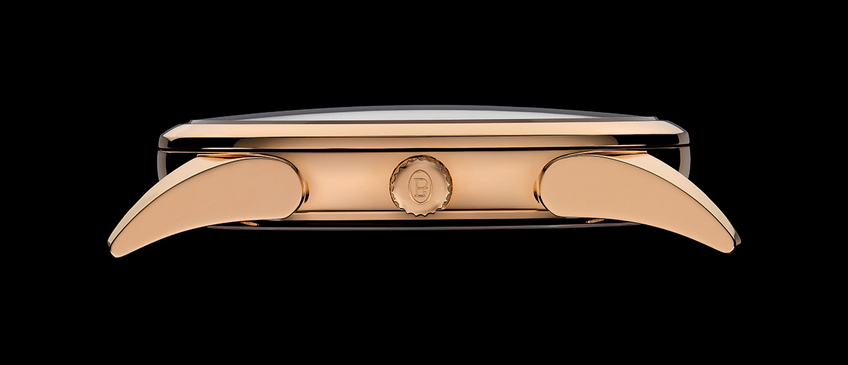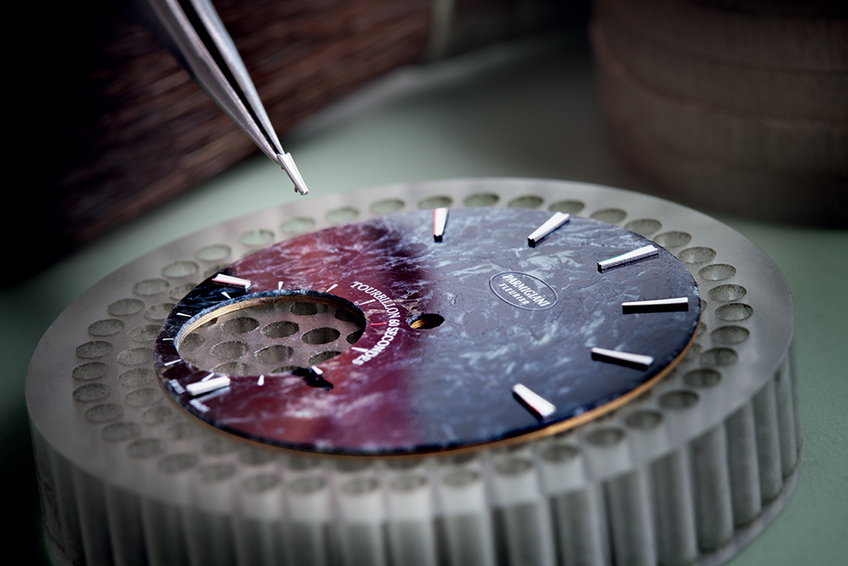
The Tourbillon: a duel with the force of gravity
The Tourbillon: a duel with the force of gravity
During the 19th century, when the Tourbillon was invented, watches carried vertically in the pocket were subject to the effects of gravity, which caused the balance-spring to become unbalanced and eventually affected the accuracy of the timepiece. The Tourbillon uses a constant rotation system to ensure that gravity acts on all the angles of the balance plane to reduce its unwanted effects.
Nowadays, the whole regulating organ is contained in a mobile cage maintained on a single pivot point, specific to this collection. Rotating once per minute on its own axis, this high-tech cage minimises most of the watch’s rate variations in the vertical position. The Tourbillon offers a fascinating view of a mechanism that pulses like a beating heart. Never has a timepiece seemed so alive.

The Parmigiani Fleurier manufacturing centre presents the world’s thinnest automatic flying tourbillon with micro-rotor (3.4mm). This feat of technology required two years of research and development. From design to production, each stage involved designers, engineers and master watchmakers working in complete harmony to breathe life into this slim masterpiece.
Features of an ultra-thin calibre.
The micro-rotor in 950 platinum which winds the movement is the component that determines the thinness of the movement PF517. It is directly integrated in the main plate, without adding to the thickness with an extra layer. In design terms, the development is certainly attractive. However, it actually represents a significant challenge. The limited space had to be managed by integrating the micro-rotor, the barrel, the tourbillon cage, the time-setting mechanism and the central display system in the same main plate. This problem can be solved by offsetting the time display, but Parmigiani Fleurier adopted its own approach, arranging the movement components with pinpoint precision to keep the time displayed in the centre.
To economise on space, Parmigiani Fleurier created a “flying” tourbillon whose special feature is a cage mounted on a single support bridge. A highly sophisticated ball bearing replaces the mounting function, without adding to the thickness of the movement. Flush with the surface and therefore visible in the foreground, the cage appears to float weightlessly in front of the movement. The tourbillon of this ultra-thin model dances before the eyes to produce a captivating, almost hypnotic visual effect.
The quest for perfect chronometry thanks to a titanium tourbillon cage.
The tourbillon improves the chronometry of the timepiece thanks to its constant revolutions which distribute the effects of gravity over the complete rotation, eliminating disruptive effects on the mechanism. Parmigiani Fleurier has applied several technical improvements to make the tourbillon’s operation more fluid and regular than ever.
A titanium tourbillon cage – the world’s lightest (0.255 g)
The tourbillon cage is usually made from steel, a strong metal which is easy to work. By choosing titanium, Parmigiani Fleurier knew that it had opted for a material which is very flammable during machining, and very difficult to produce in such small dimensions. However, it is thanks to titanium that the Manufacture is able to produce the world’s lightest tourbillon cage. Its very low weight and inertia enable rotational movement with no loss of torque. The tourbillon’s efficiency is increased and the chronometry of the timepiece improved.
A variable inertia balance instead of a screw balance.
The tourbillon cage is equipped with an inertia balance which offers a very streamlined design. It differs from a traditional balance, on which the screws protrude outwards. This offers a much more streamlined structure, giving the tourbillon more stability throughout its operation.
A perfectly balanced tourbillon cage reinforced by the seconds hand.
On this timepiece, the seconds are indicated by a hand in blued steel which forms an integral part of the tourbillon cage. It performs one revolution per minute, just like the cage.
Traditional watchmakers produce this type of hand separately to the tourbillon.
It is added later, as the two components come from different production entities. Within the verticalised Parmigiani Fleurier manufacture, the aesthetic development of a product is inseparable from the work of the manufacturing centre. This hand has been designed to precisely counterbalance the weight of the other components that make up the tourbillon cage. The dialogue between all those involved in the creative process is embodied by a perfectly balanced tourbillon cage offering optimal operation.
Aesthetics: an original, seductive approach.
With its streamlined middle and clean lines, the Tonda 1950 Tourbillon is the result of the quest for simplicity and elegance that characterises this collection. The Tonda 1950 family welcomes its first Haute Horlogerie model. It is inspired by the brand’s signature aesthetic codes, which it reinterprets in a contemporary spirit.
The entire aesthetic direction of the Tonda 1950 Tourbillon is based on the notion of 07:08, in a nod to the founder of Parmigiani Fleurier, who was born at exactly this time in the Val-de-Travers in Switzerland. The complication is placed to the left of centre, just after the 7 o’clock index, while the tourbillon’s orientation is determined by an angle corresponding to 07:08, and highlighted by a red applique around the edge of the seconds.
The decoration on the movement bridges also follows an oblique pattern formed of a series of Côtes de Genève. Their design, which follows a circular arc, added an extra degree of difficulty. They take the form of a wave, reflecting the oscillations of the tourbillon which spread through the movement. The circular arc design required a very complex operation involving a recalibration for each new facet of the Côtes de Genève. There is no room for error.
A rich array of dials.
The Tonda 1950 Tourbillon is now available with five dial versions: grey mother of pearl, white or black jade, grained white, and blue abyss with Côtes de Genève decoration. The grey mother of pearl version features the same sleek, tapered indices as the original Tonda 1950. It reflects the pure elegance that has made this such a successful model. The white gold case is set with stones. It complements the play of light produced by the mother of pearl, which reflects off the real ruby cabochon.

The white and black jade dials display all the refinement of this precious stone. Their multi-faceted crystalline surface imparts depth and sophistication to the piece. The indices on these two versions have three facets, for a more technical aesthetic. A luminescent coating on the upper facet guarantees perfect readability at night.
The final versions - white grained and blue abyss with Côtes de Genève dials – feature the classic Parmigiani Fleurier treatment with their three-faceted indices; those last timepieces adorn the brand’s most exquisite creations.








